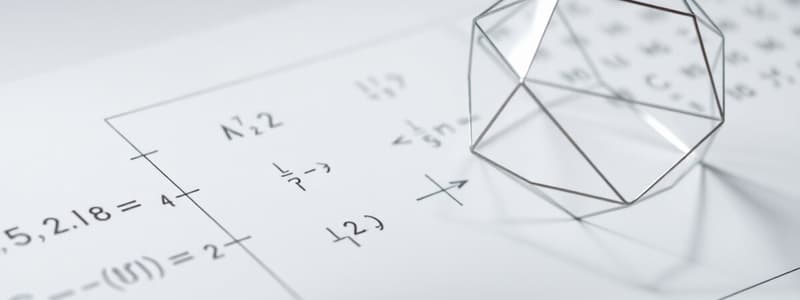Podcast
Questions and Answers
Which property of operations states that changing the order of the numbers does not change the result?
Which property of operations states that changing the order of the numbers does not change the result?
- Identity Property
- Distributive Property
- Commutative Property (correct)
- Associative Property
What is the correct name for a collection of points that have the same distance from a fixed center point?
What is the correct name for a collection of points that have the same distance from a fixed center point?
- Triangle
- Ellipse
- Polygon
- Circle (correct)
What is the primary function of trigonometric identities?
What is the primary function of trigonometric identities?
- Calculate area under curves
- Quantify data variability
- Establish relationships between angles and sides (correct)
- Graph polynomial functions
What is the significance of the Fundamental Theorem of Calculus?
What is the significance of the Fundamental Theorem of Calculus?
Which type of number includes all positive integers and their negatives?
Which type of number includes all positive integers and their negatives?
In statistics, what is the term for the average value of a data set?
In statistics, what is the term for the average value of a data set?
What is the primary purpose of combinatorics in discrete mathematics?
What is the primary purpose of combinatorics in discrete mathematics?
Which technique uses logical reasoning to establish the validity of a statement?
Which technique uses logical reasoning to establish the validity of a statement?
Flashcards are hidden until you start studying
Study Notes
Key Areas of Mathematics
-
Arithmetic
- Basic operations: addition, subtraction, multiplication, division.
- Properties: commutative, associative, distributive.
-
Algebra
- Variables and constants.
- Expressions, equations, and inequalities.
- Functions and their graphs.
- Polynomial, rational, exponential, and logarithmic functions.
-
Geometry
- Points, lines, angles, shapes (2D and 3D).
- Theorems related to triangles, circles, and polygons.
- Perimeter, area, surface area, and volume calculations.
- Coordinate geometry.
-
Trigonometry
- Relationships between angles and sides of triangles.
- Sine, cosine, tangent functions.
- Unit circle and trigonometric identities.
- Applications in real-world scenarios.
-
Calculus
- Limits and continuity.
- Derivatives: definition, rules, applications (tangent lines, rates of change).
- Integrals: definite and indefinite integrals, area under curves.
- Fundamental Theorem of Calculus.
-
Statistics and Probability
- Descriptive statistics: mean, median, mode, range.
- Probability fundamentals: events, sample space, independence.
- Probability distributions: normal, binomial, and Poisson distributions.
- Inferential statistics: hypothesis testing, confidence intervals.
-
Discrete Mathematics
- Set theory and logic.
- Combinatorics (permutations, combinations).
- Graph theory: vertices, edges, paths, and cycles.
- Algorithms and complexity.
-
Mathematical Reasoning
- Inductive and deductive reasoning.
- Proof techniques: direct proof, contradiction, and contraposition.
Important Mathematical Concepts
- Numbers: Natural, whole, integers, rational, irrational, real, and complex numbers.
- Mathematical notation: Understanding symbols and their meanings.
- Problem-solving strategies: Identify, analyze, solve, and verify.
- Real-world applications: Use of math in fields like science, engineering, finance, and technology.
Study Tips
- Practice regularly with a variety of problems.
- Focus on understanding concepts rather than just memorization.
- Use visual aids like graphs and charts for geometrical and statistical concepts.
- Collaborate with peers for discussion and problem-solving.
- Utilize online resources and math tools for additional practice and clarification.
Arithmetic
- Basic operations include addition, subtraction, multiplication, and division
- Properties of arithmetic operations include commutative, associative, and distributive properties
Algebra
- Represents unknown values with variables and known values with constants
- Involves expressions, equations, and inequalities
- Functions are a fundamental concept in Algebra and they are represented by graphs
- Different types of functions are studied including: polynomial, rational, exponential, and logarithmic functions
Geometry
- Deals with points, lines, angles, and shapes in two and three dimensions
- Explores theorems related to triangles, circles, and polygons
- Focuses on calculations like perimeter, area, surface area, and volume
- Also includes coordinate geometry, which uses coordinates to describe geometric objects
Trigonometry
- Examines the relationship between angles and sides of triangles
- Utilizes sine, cosine, and tangent functions to determine these relationships
- Uses the unit circle to represent trigonometric functions and identities
- Applicable in real-world scenarios such as navigation, surveying, and engineering
Calculus
- Fundamental concept in mathematics that deals with limits and continuity
- Analyzes derivatives and their applications including tangent lines and rates of change
- Utilizes integrals to calculate areas under curves and determine definite and indefinite integrals
- The Fundamental Theorem of Calculus establishes a connection between differentiation and integration
Statistics and Probability
- Descriptive statistics focuses on summarizing and analyzing data using measures like mean, median, mode, and range
- Probability fundamentals involve understanding events, sample space, and independence
- Different probability distributions are studied including normal, binomial, and Poisson distributions
- Inferential statistics utilizes hypothesis testing and confidence intervals to draw conclusions from data
Discrete Mathematics
- Involves Set theory and logic to study sets and their properties
- Analyzes combinatorics which deals with permutations and combinations
- Explores graph theory which involves vertices, edges, paths, and cycles
- Focuses on algorithms and complexity to analyze the efficiency of algorithms
Mathematical Reasoning
- Utilizes both inductive and deductive reasoning to draw logical conclusions
- Employs various proof techniques including direct proof, contradiction, and contraposition
Studying That Suits You
Use AI to generate personalized quizzes and flashcards to suit your learning preferences.




